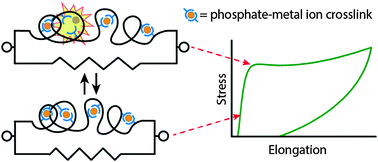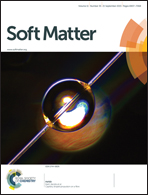Toughened hydrogels inspired by aquatic caddisworm silk
Abstract
Aquatic caddisworm silk is a tough adhesive fiber. Part of the toughening mechanism resides in serial, Ca2+–phosphate crosslinked nano-domains that comprise H-fibroin, the major structural protein. To mimic the toughening mechanism, a synthetic phosphate-graft-methacrylate prepolymer, as a simple H-fibroin analog, was copolymerized within a covalent elastic network of polyacrylamide. Above a critical phosphate sidechain density, hydrogels equilibrated with Ca2+ or Zn2+ ions displayed greatly increased initial stiffness, strain-rate dependent yield behavior, and required 100 times more work to fracture than hydrogels equilibrated with Mg2+ or Na+ ions. Conceptually, the enhanced toughness is attributed to energy-dissipating, viscous unfolding of clustered phosphate–metal ion crosslinks at a critical stress. The toughness of the bioinspired hydrogels exceeds the toughness of cartilage and meniscus suggesting potential application as prosthetic biomaterials. The tough hydrogels also provide a simplified model to test hypotheses about caddisworm silk architecture, phosphate metal ion interactions, and mechanochemical toughening mechanisms.


 Please wait while we load your content...
Please wait while we load your content...